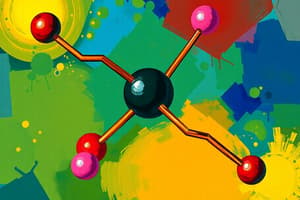Podcast
Questions and Answers
What is the molecular formula of benzene?
What is the molecular formula of benzene?
- C₅H₈
- C₆H₆ (correct)
- C₄H₆
- C₄H₄
Which feature contributes to the unique properties of benzene?
Which feature contributes to the unique properties of benzene?
- Alternating triple bonds
- Linear structure
- Presence of halogens
- Alternating single and double bonds (correct)
What is the key concept behind aromaticity in cyclic compounds like benzene?
What is the key concept behind aromaticity in cyclic compounds like benzene?
- Presence of only single bonds
- Delocalization of π electrons (correct)
- High reactivity
- Absence of carbon atoms
Which naturally occurring compound found in wood demonstrates aromatic characteristics?
Which naturally occurring compound found in wood demonstrates aromatic characteristics?
What type of substitution process involves the replacement of a hydrogen atom on an aromatic ring?
What type of substitution process involves the replacement of a hydrogen atom on an aromatic ring?
In substitution reactions involving aromatic compounds, what role do electrophiles play?
In substitution reactions involving aromatic compounds, what role do electrophiles play?
What is the main feature that contributes to the exceptional stability of aromatic compounds?
What is the main feature that contributes to the exceptional stability of aromatic compounds?
Which type of reaction leads to the replacement of a hydrogen atom on an aromatic ring with an electrophile?
Which type of reaction leads to the replacement of a hydrogen atom on an aromatic ring with an electrophile?
What is the role of phenol in various plant species and industrial applications?
What is the role of phenol in various plant species and industrial applications?
Which reaction can lead to the modification of existing functional groups in aromatic compounds?
Which reaction can lead to the modification of existing functional groups in aromatic compounds?
How do tannins contribute to industrial applications beyond their role in plants?
How do tannins contribute to industrial applications beyond their role in plants?
Which class of organic molecules exhibits high mechanical strength, thermal stability, and resistance to environmental stress?
Which class of organic molecules exhibits high mechanical strength, thermal stability, and resistance to environmental stress?
Flashcards are hidden until you start studying
Study Notes
Aromatic Compounds: Exploring Molecules with Unique Properties
Aromatic compounds, a dynamic class of organic molecules, share distinct characteristics and play integral roles in various aspects of our daily lives. In this article, we'll delve into the properties and applications of these compounds, focusing on benzene, aromaticity, aromatic compounds in nature, electrophilic aromatic substitution, and substitution reactions.
Benzene: The Building Block
Benzene, C₆H₆, is a cyclic hydrocarbon consisting of six carbon atoms arranged in a hexagonal ring. The arrangement of alternating single and double bonds around the ring contributes to its unique properties. Benzene exhibits an exceptional stability and reactivity that sets it apart from other hydrocarbons.
Aromaticity
Aromaticity is a concept that refers to the unusual stability of some cyclic compounds, including benzene, due to the delocalization of π electrons around the ring. This delocalization results in a lower energy state and a more stable molecule. The presence of aromaticity also impacts the reactivity of these compounds.
Aromatic Compounds in Nature
Aromatic compounds are not exclusive to the laboratory; they also play essential roles in various natural systems. Examples of such naturally occurring aromatic compounds include:
- Lignin: A polymer found in wood that helps provide structural strength and serves as a precursor to numerous commercial products.
- Phenol: A versatile compound found in various plant species, commonly used in the production of phenolic resins and antiseptic agents.
- Tannins: Polymeric compounds found in plants that contribute to their astringency and are used in tanning leather, dyeing, and other industrial applications.
Electrophilic Aromatic Substitution
Electrophilic aromatic substitution (EAS) is a chemical reaction in which an electrophile replaces a hydrogen atom or another substituent on the aromatic ring, resulting in the formation of a new bond. This process leads to the maintenance and preservation of aromaticity in the compound.
Substitution Reactions
In addition to electrophilic aromatic substitution, aromatic compounds can undergo other reactions such as nucleophilic aromatic substitution, oxidation, and reduction. These reactions can result in the introduction of new functional groups, modifications of existing functional groups, or the cleavage of aromaticity.
Applications of Aromatic Compounds
The unique properties of aromatic compounds have led to their extensive use in various applications across multiple industries, including:
- Polymers: Aromatic compounds serve as building blocks for polymers with desirable properties such as high mechanical strength, thermal stability, and resistance to environmental stress. Examples include polycarbonate, polyamides, and polyurethane.
- Pharmaceuticals: Aromatic compounds are essential components in numerous pharmaceutical drugs, including analgesics, antidepressants, and anticonvulsants.
- Aromatic solvents: Aromatic compounds such as benzene, toluene, and xylenes have been widely used as solvents for various industrial applications.
- Pesticides: Aromatic compounds are used as intermediates in the synthesis of pesticides, such as malathion and lindane.
Conclusion
In summary, aromatic compounds are a unique class of organic molecules that exhibit exceptional stability and reactivity due to the delocalization of π electrons. These compounds play critical roles across various industries, contributing to the development of essential materials and drugs. While benzene serves as the building block for aromatic compounds, their applications extend well beyond its basic structure, highlighting the vast potential of these molecules in addressing modern challenges.
Studying That Suits You
Use AI to generate personalized quizzes and flashcards to suit your learning preferences.




